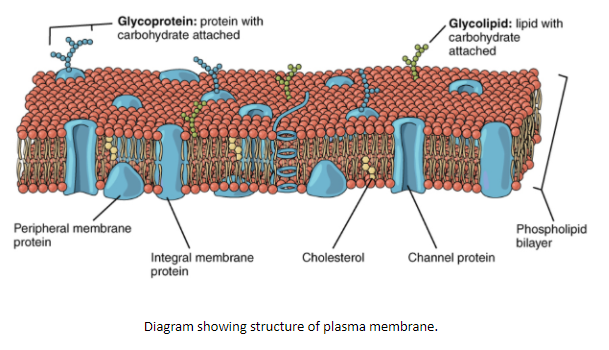
Answer
392.4k+ views
Hint: Plasma membrane is also termed as the cell membrane. It is the membrane that is present in all the cells. It distinguishes the interior of the cell from the external environment of the cell. It is semipermeable in nature and only allows the selective transport of molecules across the membrane. The lipid bilayer gives fluidity and elasticity to the membrane.
Complete answer:
Fluid mosaic model of plasma membrane:
- The fluid mosaic model of plasma membrane was proposed and given by SJ. Singer and Garth L. Nicolson in 1972.
- The fluid mosaic model of plasma membrane shows the structure of the plasma membrane.
- The plasma membrane is made up of lipid bilayer which contains the amphipathic phospholipids. The proteins are embedded in this bilipid layer. The carbohydrates are also present in the plasma membrane.
- These all components of the plasma membrane provide the membrane a fluid character.
- Plasma membrane shows its size range from 5 to 10 nm in thickness.

Additional Information:
i) Phospholipids are the class of lipids that are existing in the plasma membrane.
ii) A phospholipid is a molecule which is usually composed of glycerol, two fatty acids and one phosphate linked head group.
iii) They are amphipathic in nature in which they have a polar or hydrophilic head and a nonpolar or hydrophobic tail.
iv) Phospholipids organize themselves in a manner that their hydrophobic tails facing each other and hydrophobic heads dealing with out.
v) There is a barrier created by using this arrangement and gives a bilayer shape to the cell membrane.
Note: Plasma membrane is usually molecules or ions across itself. Plasma membranes show performance of various functions like osmosis, endocytosis, exocytosis, diffusion, etc. The non-polar molecules are easily transported through the lipid bilayer whereas the polar molecules like glucose are transported through channel proteins which are embedded in the lipid bilayer.
Complete answer:
Fluid mosaic model of plasma membrane:
- The fluid mosaic model of plasma membrane was proposed and given by SJ. Singer and Garth L. Nicolson in 1972.
- The fluid mosaic model of plasma membrane shows the structure of the plasma membrane.
- The plasma membrane is made up of lipid bilayer which contains the amphipathic phospholipids. The proteins are embedded in this bilipid layer. The carbohydrates are also present in the plasma membrane.
- These all components of the plasma membrane provide the membrane a fluid character.
- Plasma membrane shows its size range from 5 to 10 nm in thickness.

Additional Information:
i) Phospholipids are the class of lipids that are existing in the plasma membrane.
ii) A phospholipid is a molecule which is usually composed of glycerol, two fatty acids and one phosphate linked head group.
iii) They are amphipathic in nature in which they have a polar or hydrophilic head and a nonpolar or hydrophobic tail.
iv) Phospholipids organize themselves in a manner that their hydrophobic tails facing each other and hydrophobic heads dealing with out.
v) There is a barrier created by using this arrangement and gives a bilayer shape to the cell membrane.
Note: Plasma membrane is usually molecules or ions across itself. Plasma membranes show performance of various functions like osmosis, endocytosis, exocytosis, diffusion, etc. The non-polar molecules are easily transported through the lipid bilayer whereas the polar molecules like glucose are transported through channel proteins which are embedded in the lipid bilayer.
Recently Updated Pages
How many sigma and pi bonds are present in HCequiv class 11 chemistry CBSE

Mark and label the given geoinformation on the outline class 11 social science CBSE

When people say No pun intended what does that mea class 8 english CBSE

Name the states which share their boundary with Indias class 9 social science CBSE

Give an account of the Northern Plains of India class 9 social science CBSE

Change the following sentences into negative and interrogative class 10 english CBSE

Trending doubts
Fill the blanks with the suitable prepositions 1 The class 9 english CBSE

Which are the Top 10 Largest Countries of the World?

Give 10 examples for herbs , shrubs , climbers , creepers

Difference Between Plant Cell and Animal Cell

Difference between Prokaryotic cell and Eukaryotic class 11 biology CBSE

The Equation xxx + 2 is Satisfied when x is Equal to Class 10 Maths

Change the following sentences into negative and interrogative class 10 english CBSE

How do you graph the function fx 4x class 9 maths CBSE

Write a letter to the principal requesting him to grant class 10 english CBSE



